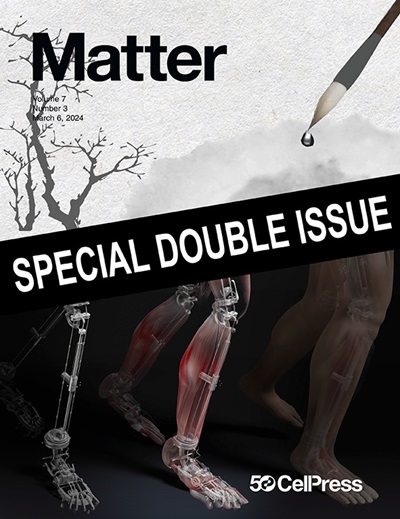Halogen and hydrogen bonded 2-X-pyridin-3-ol (X = Cl, Br, I) organic crystals with large shear piezoelectricity
IF 17.3
1区 材料科学
Q1 MATERIALS SCIENCE, MULTIDISCIPLINARY
引用次数: 0
Abstract
The confluence of crystal engineering with piezoelectric material discovery is allowing researchers to design sustainable molecular piezoelectrics at the nanoscale. Here, we use this bottom-up design approach to crystallize a series of analogous organic molecules, 2-X-pyridin-3-ol (1X; X = Cl, Br, I), with structures sustained by both halogen bonds and hydrogen bonds. Density functional theory calculations predict, quantify, and rationalize the piezoelectric response of the analogous series 1X. Our calculations reveal high shear piezoelectricity in all three crystals, with the highest predicted response of d15 = 99.19 pC/N for 1Cl. Piezoresponse force microscopy experiments confirm effective shear piezoelectric constants of 54–74 pC/N. The space groups allow for unpoled longitudinal piezoelectric responses, with experimental d33 values of 5–10 pC/N. This highlights the ability of halogen substitution to induce and modulate piezoelectricity and adds to the growing number of molecular crystals approaching triple-digit piezoelectric responses to rival conventional perovskite ceramics.


卤素和氢键结合的2-X-吡啶-3-醇(X = Cl, Br, I)有机晶体具有大剪切压电性
晶体工程与压电材料发现的融合使研究人员能够在纳米尺度上设计出可持续的分子压电材料。在这里,我们使用这种自下而上的设计方法来结晶一系列类似的有机分子,2- x -吡啶-3-醇(1X;X = Cl, Br, I),其结构由卤素键和氢键维持。密度泛函理论计算预测,量化,并合理化压电响应的类似系列1X。我们的计算表明,这三种晶体都具有较高的剪切压电性,对1Cl的预测响应最高,为d15 = 99.19 pC/N。压电响应力显微镜实验证实了有效剪切压电常数为54 ~ 74 pC/N。空间组允许非极化纵向压电响应,实验d33值为5-10 pC/N。这突出了卤素取代诱导和调制压电的能力,并增加了越来越多的接近三位数压电响应的分子晶体,以与传统的钙钛矿陶瓷相媲美。
本文章由计算机程序翻译,如有差异,请以英文原文为准。
求助全文
约1分钟内获得全文
求助全文
来源期刊

Matter
MATERIALS SCIENCE, MULTIDISCIPLINARY-
CiteScore
26.30
自引率
2.60%
发文量
367
期刊介绍:
Matter, a monthly journal affiliated with Cell, spans the broad field of materials science from nano to macro levels,covering fundamentals to applications. Embracing groundbreaking technologies,it includes full-length research articles,reviews, perspectives,previews, opinions, personnel stories, and general editorial content.
Matter aims to be the primary resource for researchers in academia and industry, inspiring the next generation of materials scientists.
 求助内容:
求助内容: 应助结果提醒方式:
应助结果提醒方式:


